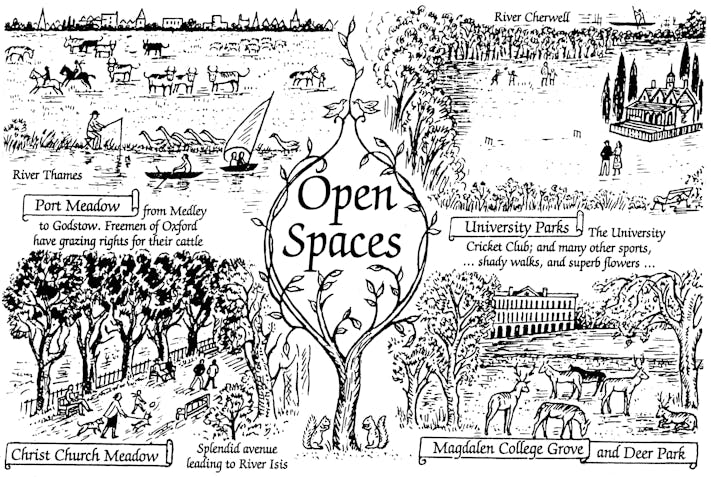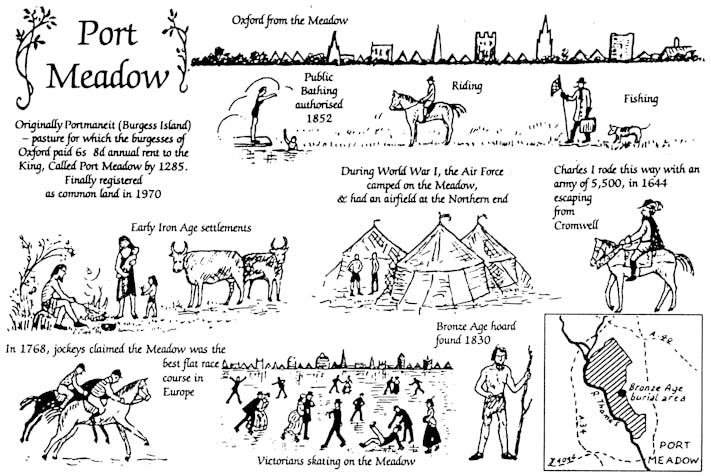Open Spaces

"The Parks, opposite Keble, are what is, in any other town, called a park." (Betjeman). The policy of the curators has been to provide "as many interesting trees as possible without detracting from the natural beauty of the indigenous by an excess of the exotic". The University Parks also contain the only first-class UK cricket grounds which are always free for the public to access.
It is alarming to contemplate the threat that overshadowed Christ Church Meadow for much of the latter part of this century. In 1933 it was suggested that a four lane highway be built across it to relieve Oxford traffic, and proposals for a sunken road were still being put forward as recently as 1968. The combined efforts of the citizens and past and present members of Christ Church (including seven members of the cabinet) eventually squashed any suggestion of such a scheme.
There are three main paths across Christ Church Meadow:
Broad Walk has long been a popular route, and rests on material from the foundations of Christ Church. In the Civil War it was dug up to form defensive trenches against Cromwell's troops.
Poplar Walk was formed by Dean Liddell to cope with the increasing number of people wanting to reach the river for boating trips. These included, of course, Charles Dodgson and Alice.
Dead Man's Walk is so named because it was the route taken by funeral processions from the Synagogue to the Jewish burial ground. This was on the site of the Botanical Gardens.
Magdalen Deer Park is first mentioned in 1706, and even today the college has a reputation for its venison. Nearby is the 'Magdalen plane' which is 185 years old, and the entrance to the 'Water Walks' or 'Addison's Walks' – a delightful circuit of about a mile, which takes you along the river banks.
Further afield there are many other lovely parks much used by families, including Hinksey with its outdoor pool, Florence Park with bandstand, playgrounds and sandpit, Cutteslowe with its miniature ride-on railway and butterfly house, and of course South Park, home of various festivals and of the Round Table's grand fireworks display around 5th November and much beloved by students wanting somewhere to relax or have barbecues.
Port Meadow

Disputes between Oxford and Wolvercote over the ownership of Port Meadow raged from the 13th to the 20th century. The Abbess of Godstow several times blocked the main burgesses’ entrance (then by Aristotle Lane) and was required by law to repair it. By 1970, grazing rights established by 130 Wolvercote householders (entitled to graze anything from a few geese to 60 head of cattle each) outweighed those established by Oxford Freemen. However, once a year the Sheriff of Oxford would ride out with the Freemen to impound the animals. They were then given back to their owners on payment of a £3 fine. The date changed from year to year, and was kept a strict secret beforehand. The Sheriff usually conducted operations from horseback, except for one in the early sixties who, as a member of the RAF, preferred to do so from a helicopter.
While Port Meadow is now common land, tempers still run high when there is any suggestion of change or development. Not only do the local residents enjoy the possibility of country walks just beyond their back gates, but the ecology of the boggy ground, left virtually untouched for hundreds of years, is of great interest to naturalists. The closest the meadow ever came to planned development was in the harsh winter of 1860-1. A subscription was raised to provide work for the poor, which took the form of building walks on the meadow. Sir Richard Cresswell intended to carry on the work at his own expense and planned a circuit of walks, planted with willows and flower borders. Opposition from the Freemen of the City prevented him from doing this.
Now used by private horse owners and riding schools, the meadow was for centuries a popular site for horse racing, and its peak of excellence in 1768 was the result of work paid for by the Duchess of Marlborough. By the mid 18th century the race meetings had become important social occasions, estimated to be worth £2,000 to the city in trade. The last race meeting was held in 1880, after 40 years of disputes over rights to use the meadow.
Port meadow provides some of the most picturesque easy walks within reach of central Oxford. Best of all, by walking away from Oxford along the West side of the meadow, one encounters first the Perch, and then, by walking all the way to Godstow, the Trout, both of which are fine old-fashioned pubs which serve good food and beer.



